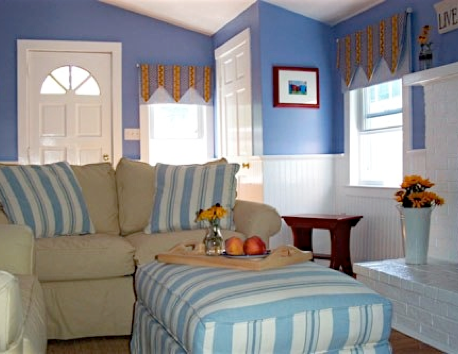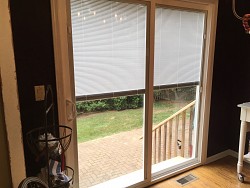Easy-to-Sew Window Treatments
 I’m a big fan of fabric and it’s usually the first thing I look at what starting an interior design project. There are so many beautiful textiles available from cut yardage goods to repurposed bedding and table linens. And best yet, even those with the most basic of sewing skills can whip up easy sew window treatments quickly. Here are a few ideas:
I’m a big fan of fabric and it’s usually the first thing I look at what starting an interior design project. There are so many beautiful textiles available from cut yardage goods to repurposed bedding and table linens. And best yet, even those with the most basic of sewing skills can whip up easy sew window treatments quickly. Here are a few ideas:
1) Flat sheets make great window panels. The standard size of twin sheets is 66”W x 99”L (106” for XL). This is the perfect width for a standard 30-40” wide window for a nice amount of fullness. Years ago in one of my first apartments, I made completely no-sew drapery panels by hanging a pair of twin size flat sheets off of tension rods mounted inside the window frames. I swagged the panels back to each side and held them in place with a ribbon that was attached to an eyelet-hook. The hemmed placket that is at the top of all sheets had open ends, so slipping them over the tension rods was nothing. If the ends are sewn shut, it’s easy to cut the seam open (not the fabric, just the thread!) or fold the whole placket over again and sew a simple seam across the top, leaving the ends open to accept a rod. Lining material can also be added if you wish for room darkening options.
2) Repurposed table cloth valances: I did the interior design plan for a friend’s beachy cottage living room a while ago. We hadn’t yet found a fabric we liked for window treatments when her husband pointed to a very pretty Provencal patterned tablecloth she had just purchased and said he thought it was pretty. In fact, the pattern was so perfect for the windows that she was willing to forgo having it on her table. She made very simple flat panels that were about the size of a king size pillowcase. One end had large three triangle points and the other end was straight. She used a coordinating fabric for the backside. The sewing was simply pinning the front and backsides together, right side in, and sewing a simple seam all the way around, leaving a 5” opening to turn the treatment right side out. Her husband made curtain rods from unpainted wood dowels cut to size and finished on the ends with coordinating porcelain drawer pulls for finials. The rods were attached with o-rings and the valance panels were simply draped over the rod, with the coordinating fabric showing behind the downward pointing triangles of the face fabric.
3) Vintage hand towels add whimsy: Vintage hand towels and grain sacks have been all the rage for a while. These time-worn pieces have the patina of age and a sense of history about them, which makes them perfect choices for cute little window treatments. A couple of years ago, when my kitchen remodel was still in the planning stages, I came across a cute pair of striped cotton hand towels that I though would make a sweet and summery valance treatment for the kitchen window. The roman shade that was in the window had seen better days and needed replacing, but I wasn’t ready to put in a new shade until the remodel was completed. I sewed the two hand towels together by the short ends and then folded over one of the long-ends and stitched with a simple seam to create a rod pocket. It was then hung on the existing rod in the window, pulled into soft gathers. Very quick and easy. So easy, in fact, that I didn’t think twice about replacing it a few months later when the kitchen was finished.
4) Burlap roman shade: To make the new shade for my remodeled kitchen, I used the original store bought roman shade as the pattern. I ironed it out flat and opened the ends up and cut one piece out of burlap and one piece from a plain lining material, adding in seam allowances. The pieces were simple rectangles that I sewed together and turned right side out, hand-stitching the opening closed, and made top and bottom plackets by turning over the ends and running a simple seam. I re-used the old shade rigging ropes and the wooden dowel that stabilized the shade bottom. I purchased new ring tape and sewed it onto the backside of the shade treatment and copied the placement of the rigging. The treatment was hung off the original rod and was a perfect fit.
All of these ideas require only the most basic machine sewing skill of sewing a straight line, which anyone can master in no time. None of these projects took more than 90 minutes to produce.
Looking for a Pro? Call us (866) 441-6648

Remodeling Average Costs
Remodeling Contractors Experiences

Tree Removal So Fast And Efficient It Didn’t Even Wake Our Newborn

Sliding Glass Patio Door Replacement Eliminates Rotten Wood



